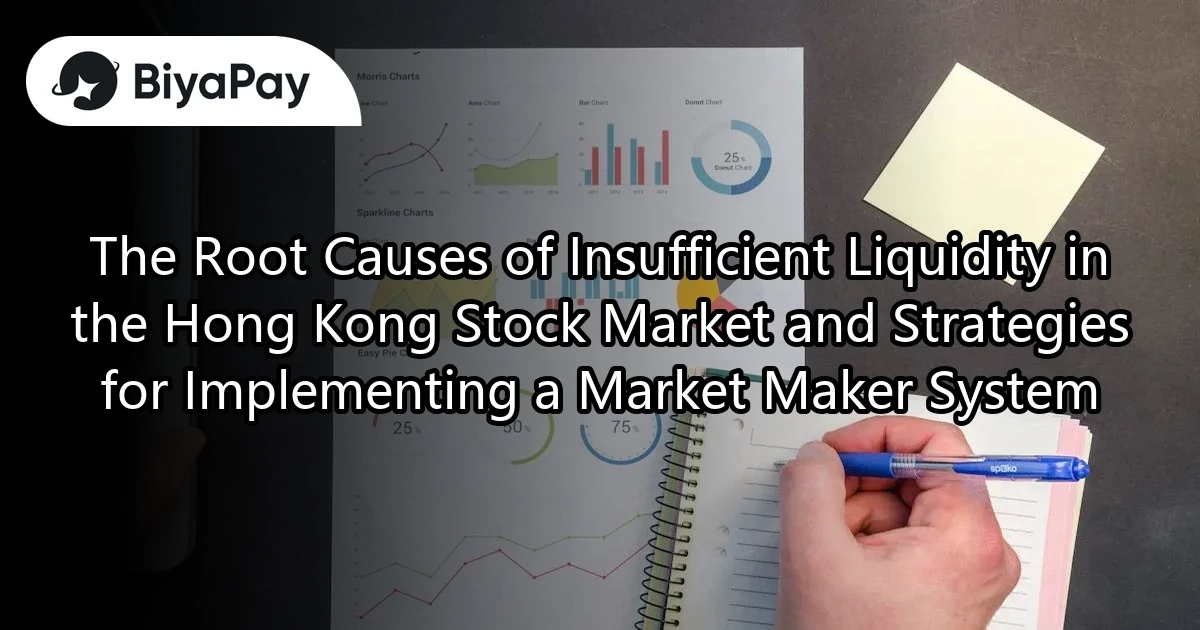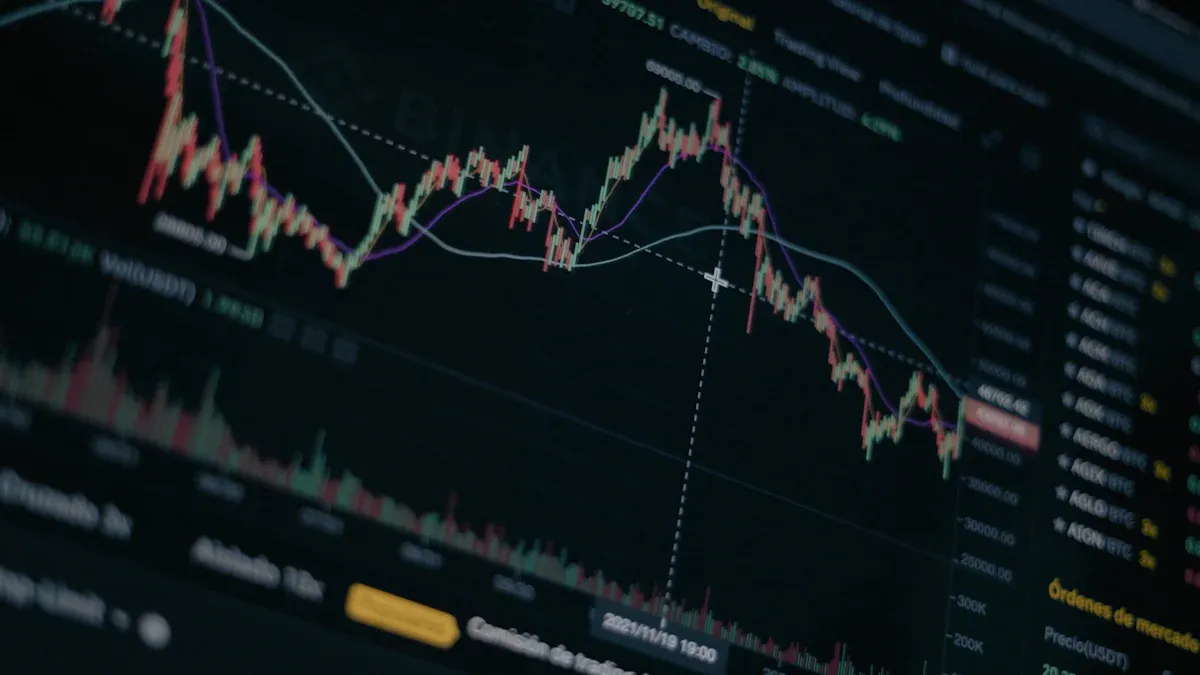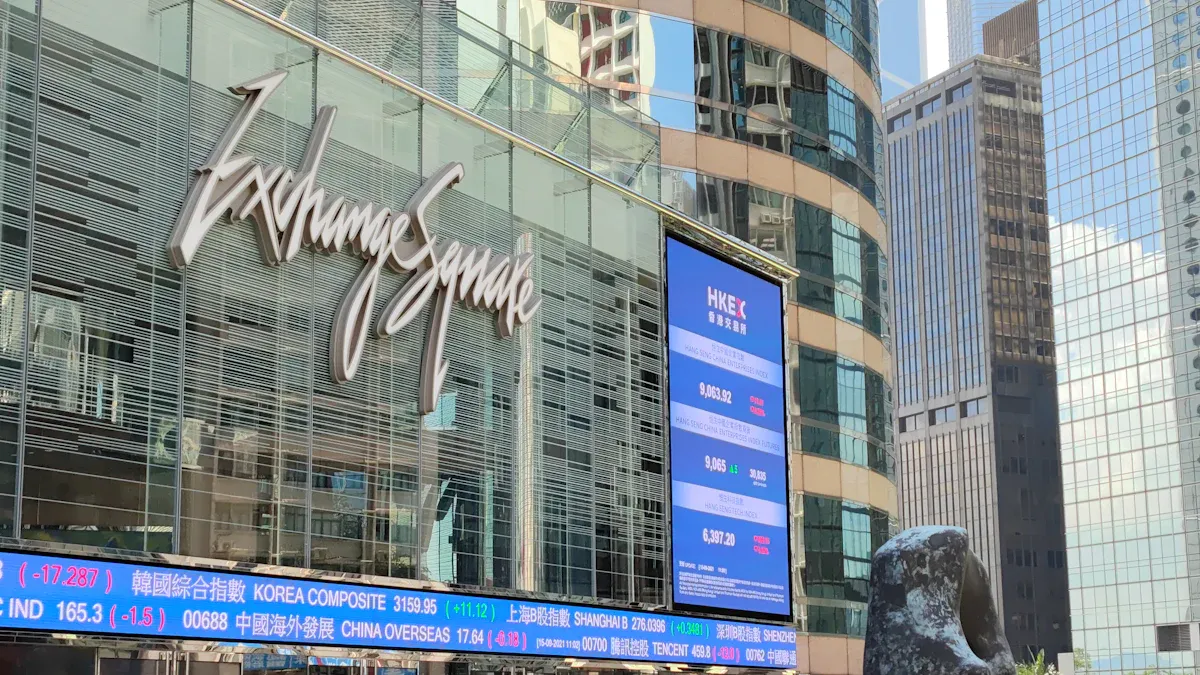- EasyCard
- Trade
- Help
- Announcement
- Academy
- SWIFT Code
- Iban Number
- Referral
- Customer Service
- Blog
- Creator
The Root Causes of Insufficient Liquidity in the Hong Kong Stock Market and Strategies for Implementing a Market Maker System

Image Source: pexels
In recent years, the Hong Kong stock market has faced challenges with insufficient liquidity, significantly impacting market efficiency. The latest data shows that, despite monetary policies releasing substantial liquidity, funds have not effectively circulated into the real economy. For example, in April 2023, China’s new social financing recorded negative growth for the first time since 2005, indicating low market fund vitality, unable to support consumption and investment. This situation has led to a decline in investors’ willingness to trade, further weakening market activity.
Against this backdrop, the market maker system in Hong Kong is seen as a critical tool for addressing liquidity shortages. This system not only stabilizes market liquidity but also narrows bid-ask spreads, attracting more investors to participate, thereby enhancing market efficiency and appeal.
Main Reasons for Insufficient Liquidity in the Hong Kong Stock Market
Low Participation of Retail Investors
The lack of liquidity in the Hong Kong stock market is closely tied to low participation by retail investors. According to market observations, trading in Hong Kong stocks is primarily dominated by institutional investors, with a relatively low proportion of retail investors. This leads to reduced trading activity, especially during periods of low volatility. The low participation of retail investors may stem from the following factors:
- Insufficient Investment Knowledge: Many retail investors lack a deep understanding of how the Hong Kong stock market operates and have limited awareness of investment risks.
- High Capital Threshold: The investment threshold in the Hong Kong stock market is relatively high, making it difficult for small-scale investors to enter the market.
- Lack of Market Appeal: Compared to other markets, the returns and investment opportunities in Hong Kong stocks have not attracted more retail investors.
Increasing retail investor participation requires strengthening market education, providing more investment tools, and lowering investment thresholds.
High Transaction Costs
Transaction costs are a significant factor affecting market liquidity. Transaction costs in the Hong Kong stock market include commissions, stamp duties, and other related fees, which directly impact investors’ willingness to trade. High transaction costs may lead to the following issues:
- Reduced Trading Frequency: Investors may reduce trading frequency due to high costs, further lowering market activity.
- Restricted Capital Flow: Liquidity of funds is constrained, reducing the efficiency of capital in the market.
- Impact on IPOs: High costs may dampen investor interest in new stock offerings, affecting the performance of the IPO market.
According to a Citibank study, recent capital inflows into Hong Kong have reached levels seen during the 2007 bull market peak, indicating ample liquidity. However, the influx of hot money has driven up the Hong Kong stock market and affected the performance of the A-share market. While ample liquidity is considered a key driver of market growth, high transaction costs remain a barrier to further market development.
Lack of a Market Maker System in Hong Kong
The current lack of a robust market maker system in the Hong Kong stock market is one of the core reasons for insufficient liquidity. The absence of a market maker system leads to the following issues:
- Wide Bid-Ask Spreads: The lack of stable liquidity providers results in wider bid-ask spreads, affecting trading efficiency.
- Increased Market Volatility: Without market maker support, the market is prone to sharp fluctuations during periods of low liquidity.
- Lack of Investor Confidence: Investors lose confidence in the Hong Kong stock market due to low liquidity, further reducing participation.
The introduction of a market maker system in Hong Kong can effectively address these issues. This system can provide stable liquidity, narrow bid-ask spreads, and reduce market volatility, thereby attracting more investors to participate.
Impact of Market Structure and Regulatory Restrictions
The insufficient liquidity in the Hong Kong stock market partly stems from the impact of market structure and regulatory restrictions. These factors not only affect capital liquidity but also have a profound impact on investors’ trading behavior.
Challenges of Market Structure
The market structure of the Hong Kong stock market is dominated by institutional investors, with relatively low participation from retail investors. This structure leads to high concentration in trading, causing imbalances in capital liquidity during certain periods. Additionally, the stock market in Hong Kong has a high concentration of stocks, with trading volumes of a few large companies dominating, further limiting the liquidity of small and medium-sized enterprises’ stocks.
Another challenge in market structure lies in the arrangement of trading hours. Compared to other international markets, the trading hours of the Hong Kong stock market are relatively short, which may restrict the efficiency of capital flow. Extending trading hours or introducing more flexible trading mechanisms could help improve this issue.
Impact of Regulatory Restrictions
Regulatory policies have a dual impact on market liquidity. On one hand, strict regulations help maintain market stability and prevent excessive speculation; on the other hand, overly stringent regulations may suppress market activity and reduce capital liquidity. For example, the stamp duty policy in the Hong Kong market increases transaction costs, negatively affecting investors’ willingness to trade.
According to a study on Taiwan’s banking industry, regulatory policies have a significant impact on liquidity risk. The study analyzed the operational performance of 35 Taiwanese banks from 2015 to 2019, finding that increasing the liquidity coverage ratio had a significant negative impact on banks’ operational performance. The increase in capital adequacy ratios and non-performing loan ratios also had adverse effects. Here are the main findings of the study:
| Research Topic | Research Subject | Research Period | Main Findings |
|---|---|---|---|
| Impact of Liquidity Risk Regulatory Policies on the Operational Performance of Taiwanese Banks | 35 Taiwanese Banks | Q1 2015 to Q4 2019 | Increasing the liquidity coverage ratio has a significant negative impact on banks’ operational performance, with increases in capital adequacy ratios and non-performing loan ratios also having adverse effects. |
Although this study focuses on the banking industry, its findings are relevant to the Hong Kong stock market. Regulatory policies need to balance stability and liquidity to avoid suppressing market vitality due to excessive restrictions.
Improvement Suggestions
To address the challenges posed by market structure and regulatory restrictions, the Hong Kong market can consider the following strategies:
- Optimize Market Structure: Encourage listings of small and medium-sized enterprises to diversify market trading concentration and enhance overall liquidity.
- Adjust Regulatory Policies: Reduce transaction-related taxes to alleviate investor burdens and attract more capital into the market.
- Extend Trading Hours: Align with international markets to provide more trading opportunities and improve capital flow efficiency.
Through these measures, the Hong Kong stock market is expected to enhance liquidity and appeal while maintaining stability.
The Role and Advantages of the Hong Kong Market Maker System

Image Source: pexels
Providing Stable Market Liquidity
The core role of the Hong Kong market maker system is to provide stable market liquidity. Market makers, as liquidity providers, ensure that the market can facilitate buying and selling at any time by continuously quoting prices and executing trades. This stability is crucial for enhancing market efficiency, especially during periods of high volatility or low trading volume.
According to a report by China Securities, widely introducing a market maker system is expected to provide more liquidity to the market. The market maker mechanism introduced by the Hong Kong Stock Exchange for ETF products and dual-counter trading has already made positive contributions to enhancing market liquidity.
Moreover, market makers’ participation can improve the speed and certainty of trade execution, reducing delays caused by insufficient liquidity. This is significant for attracting more investors to participate in the Hong Kong stock market.
Reducing Bid-Ask Spreads
Another major advantage of the market maker system is narrowing bid-ask spreads. Bid-ask spreads are a key component of investors’ transaction costs, and excessively wide spreads can reduce investors’ willingness to trade, further impacting market liquidity. By continuously providing two-way quotes, market makers can effectively narrow bid-ask spreads, thereby reducing investors’ transaction costs.
- Active market makers can:
- Provide more competitive quotes.
- Reduce price asymmetry in the market.
- Enhance the transparency and fairness of trading.
For example, if the Hong Kong stock market can introduce a more robust market maker mechanism in the future, it will help address the liquidity shortages of certain stocks and further enhance the market’s appeal.
Reducing Market Volatility
Excessive market volatility can negatively impact investor confidence and even lead to capital outflows. The Hong Kong market maker system can mitigate sharp market fluctuations by providing stable liquidity. During extreme market conditions, market makers can balance supply and demand by adjusting quotes and trading volumes, thereby reducing volatility.
The Hong Kong stock market has a high concentration of stocks, with trading volumes of a few large companies dominating. This structure can lead to imbalances during certain periods. Market makers’ participation can effectively alleviate this issue, providing a stable trading environment for the market.
Additionally, a stable market environment can boost investor confidence, attract more capital inflows, and create a virtuous cycle. This is significant for enhancing the international competitiveness of the Hong Kong stock market.
Enhancing Investor Confidence and Participation
Investor confidence is a core driver of market liquidity. The liquidity shortage in the Hong Kong stock market is partly due to insufficient investor confidence. Enhancing investor confidence and participation requires efforts on multiple fronts, including improving market transparency, providing more investment tools, and establishing a stable trading environment.
Improving Market Transparency
Transparency is a key factor in attracting investors. The Hong Kong stock market needs to strengthen its information disclosure mechanisms to ensure investors have access to accurate and timely market information. The following measures can enhance transparency:
- Strengthen Corporate Information Disclosure: Require listed companies to regularly disclose financial reports and major events to reduce information asymmetry.
- Establish Data Sharing Platforms: Provide a unified market data platform to facilitate investors’ access to trading data and market dynamics.
- Promote Regulatory Transparency: Regulatory authorities should regularly publish policy updates and market oversight developments to enhance investor trust in the market.
Increased transparency can reduce investor concerns, encouraging more capital to flow into the Hong Kong stock market.
Providing Diverse Investment Tools
Diverse investment tools can attract different types of investors to participate in the market. The Hong Kong stock market can consider introducing more innovative financial products, such as:
- Derivatives: Launch more options and futures products to meet investors’ hedging needs.
- ETFs: Expand the variety of exchange-traded funds (ETFs) to provide low-cost, high-liquidity investment options.
- Green Financial Products: Develop financial instruments related to sustainable development to attract environmentally conscious investors.
These tools can meet the needs of different investors, enhancing market appeal.
Establishing a Stable Trading Environment
A stable trading environment is the cornerstone of boosting investor confidence. The Hong Kong market maker system plays a significant role in this regard. By continuously providing liquidity, narrowing bid-ask spreads, and reducing market volatility, market makers can effectively improve the trading environment. Specific measures include:
- Introducing More Market Makers: Encourage more financial institutions to participate as market makers to expand market liquidity.
- Monitoring Market Volatility: Establish a market volatility monitoring system to take timely measures to stabilize the market.
- Optimizing Trading Mechanisms: Introduce hybrid trading models combining market maker systems with auction trading to enhance trading efficiency.
A stable trading environment can enhance investors’ sense of security, encouraging more capital to enter the market.
Promoting Market Education
Market education is a long-term strategy to increase investor participation. Hong Kong can strengthen market education through the following methods:
- Host Investor Education Events: Regularly hold seminars and workshops to promote knowledge about the Hong Kong stock market.
- Provide Online Learning Resources: Establish investor education websites offering free investment courses and market analysis tools.
- Collaborate on Promotion: Partner with financial institutions to launch education programs for novice investors.
Education can help investors better understand market operations and boost investment confidence.
Enhancing International Investor Participation
Attracting international investors is a key way to enhance liquidity in the Hong Kong stock market. Hong Kong can adopt the following strategies to attract more international capital:
- Expand Interconnectivity: Strengthen ties with mainland China and other international markets to provide more cross-border investment opportunities.
- Simplify Foreign Investment Processes: Lower barriers for foreign capital to enter the Hong Kong stock market and provide convenient trading services.
- Enhance Market Competitiveness: Strengthen the international appeal of the Hong Kong stock market through policy support and institutional innovation.
The participation of international investors can inject more liquidity into the Hong Kong stock market, creating a virtuous cycle.
The introduction of the Hong Kong market maker system not only stabilizes market liquidity but also enhances investor confidence and participation. This has profound significance for improving the overall competitiveness of the Hong Kong stock market.
Lessons from Market Maker Systems in International Markets
The Market Maker Model in the U.S. Market
The market maker system in the U.S. market is renowned for its efficiency and flexibility, providing an important reference for global financial markets. Market makers in the U.S. are primarily concentrated in NASDAQ and the New York Stock Exchange (NYSE), and the success of these markets is largely due to the active participation of market makers.
- Market makers play a critical role in the U.S. market. They ensure market liquidity and trading efficiency by continuously quoting bid and ask prices.
- According to data analysis, companies like Feichen International have leveraged precise product selection and the ability to quickly adapt to market demands, successfully launching multiple brands and products, demonstrating agile market responsiveness.
- Additionally, market makers rely on efficient logistics systems (such as FBA) to streamline shipping processes and enhance market competitiveness.
These measures not only improve market transparency but also attract more investors, further enhancing market liquidity.
Successful Cases in the European Market
The market maker system in the European market also demonstrates its advantages in improving market liquidity. For example, the London Stock Exchange (LSE) employs a multi-tiered market maker model to serve different types of investors.
- The European market maker system emphasizes market stability. By continuously quoting prices and executing trades, market makers reduce market volatility.
- In stock index options trading, the proprietary trading departments of securities firms demonstrate the importance of market makers in providing liquidity through market-making and arbitrage activities.
- Market makers compensate their costs through bid-ask spreads and achieve stable returns, further proving the system’s role in improving market liquidity.
The success of the European market shows that a robust market maker system can effectively enhance market efficiency and provide a more stable trading environment for investors.
Application of Market Makers in the ETF Market
The ETF market is a prime example of the application of the market maker system, offering valuable lessons for other markets. The role of market makers in the ETF market is reflected in the following aspects:
- They can reduce transaction costs and narrow bid-ask spreads, attracting more investors to participate.
- In markets with low liquidity, market makers’ participation helps reduce market volatility, creating a more stable trading environment.
- These efforts not only enhance market liquidity but also boost investor confidence.
For example, the market maker mechanism introduced by the Hong Kong Stock Exchange for ETF products has made positive contributions to improving market liquidity. This demonstrates the significance of applying the market maker system to drive market development.
The experiences of international markets show that the market maker system has significant effects in enhancing market liquidity, stability, and appeal. These successful cases provide valuable references for the future development of the Hong Kong stock market.
Implications for the Hong Kong Stock Market
The successful experiences of international markets offer valuable lessons for the Hong Kong stock market, particularly in the design and implementation of the market maker system. The following points are worth considering for the Hong Kong market:
- Establish a Multi-Tiered Market Maker Model
The multi-tiered market maker model of the London Stock Exchange demonstrates how to meet the needs of different investors. The Hong Kong stock market could consider introducing a similar tiered mechanism, setting different market maker participation standards for large-cap and small-to-mid-cap stocks to enhance overall liquidity. - Strengthen Market Transparency
The U.S. market’s market maker system emphasizes information disclosure and transparency. The Hong Kong stock market should further improve its corporate information disclosure mechanisms to ensure investors have timely access to accurate market information. For example, establishing a unified data-sharing platform would make it easier for investors to access trading data. - Promote Innovative Financial Products
The success of the ETF market shows that innovative financial products can significantly enhance market appeal. The Hong Kong stock market could consider expanding the variety of ETF products and introducing more green financial instruments related to sustainable development to attract international capital inflows.
Tip: According to NASDAQ’s experience, market maker participation can effectively narrow bid-ask spreads, reduce investor transaction costs, and improve market efficiency.
- Optimize Regulatory Policies
The European market’s experience shows that balanced regulation can maintain market stability while supporting liquidity. The Hong Kong stock market could consider reducing transaction-related taxes (such as stamp duties) to alleviate investor burdens and attract more capital into the market. - Enhance Internationalization
The Hong Kong stock market should strengthen ties with other international markets, expand interconnectivity, and simplify foreign investment processes. This will help attract more international investors, further enhancing market liquidity and competitiveness.
In summary, the successful cases of international markets demonstrate that a robust market maker system can enhance market liquidity and investor confidence. If the Hong Kong stock market can draw on these experiences, it is expected to achieve higher market efficiency and appeal.
Challenges and Strategies for Implementing the Market Maker System in Hong Kong
Adaptability of the Regulatory Framework
Implementing the market maker system in Hong Kong poses significant challenges in terms of regulatory framework adaptability. The existing regulatory policies are primarily designed for traditional trading models, lacking clear guidelines for the roles and responsibilities of market makers. This may lead to concerns among market participants about the transparency and fairness of the system. Additionally, regulatory authorities need to balance market stability and liquidity to avoid excessive regulation stifling market vitality.
To address this issue, regulatory authorities should consider drawing on the successful experiences of international markets. For example, the market maker systems in the U.S. and European markets provide clear regulatory guidelines, ensuring market participants can follow unified rules. At the same time, Hong Kong could establish a dedicated regulatory department to oversee market maker operations and regularly evaluate the system’s effectiveness.
Market Participants’ Acceptance
The acceptance of market participants directly affects the success of implementing the Hong Kong market maker system. Some investors may be unfamiliar with or even resistant to the new system’s operations. According to market surveys, quantitative data can quickly reflect participants’ attitudes, but qualitative interviews better reveal the underlying reasons. For instance, surveys show that some investors are concerned that market makers may manipulate market prices, while qualitative analysis indicates that this concern stems from doubts about the system’s transparency.
To improve acceptance, Hong Kong should strengthen market education to explain the operational principles and advantages of the market maker system to investors. Additionally, regulatory authorities could hold public consultation sessions to gather feedback from market participants and optimize the system accordingly.
Need for Capital and Technical Support
Implementing the Hong Kong market maker system requires substantial capital and technical support. Market makers need strong financial capabilities to manage risks arising from market volatility. Meanwhile, advanced technical systems, such as automated quoting systems and risk management tools, are critical for achieving efficient trading.
Hong Kong can attract international financial institutions to participate as market makers to provide capital support. Additionally, the government and regulatory authorities should encourage local fintech companies to develop innovative technologies to enhance the market’s technical infrastructure. This will not only improve market makers’ operational efficiency but also strengthen the market’s international competitiveness.
Policy Recommendations to Address Challenges
To effectively address the challenges of implementing the market maker system in Hong Kong, policymakers need to adopt multifaceted strategies to ensure its successful rollout and enhance market liquidity. Here are some specific recommendations:
1. Establish a Clear Regulatory Framework
Regulatory authorities should develop specific regulations for market makers, clearly defining their roles, responsibilities, and rights. These regulations should include the following:
- Minimum Capital Requirements: Ensure market makers have sufficient financial strength to handle market volatility.
- Transparency Requirements: Require market makers to regularly disclose trading data and quoting behavior to enhance market transparency.
- Risk Management Guidelines: Provide measures to address extreme market conditions to reduce systemic risks.
Tip: Drawing on NASDAQ’s regulatory model, Hong Kong could establish a dedicated department to oversee market maker operations and conduct regular reviews.
2. Provide Financial and Technical Support
The government and regulatory authorities should provide necessary financial and technical support for market makers to reduce their operational costs and improve efficiency.
- Financial Subsidies: Offer subsidies to market makers participating in small and medium-sized enterprise stocks to encourage their involvement.
- Technical Upgrades: Promote the development of automated quoting systems and risk management tools by fintech companies to enhance market operational efficiency.
3. Reduce Transaction Costs
High transaction costs are one of the main barriers to market liquidity. Policymakers should consider the following measures:
- Reduce Stamp Duties: Lower transaction-related taxes to alleviate investor burdens and attract more capital into the market.
- Simplify Trading Processes: Optimize trading systems to shorten settlement times and improve capital flow efficiency.
4. Strengthen Market Education and Promotion
Investors’ lack of understanding of the market maker system may affect its acceptance. Regulatory authorities should promote market education to enhance investors’ understanding and confidence in the system.
- Host Seminars and Workshops: Invite experts to explain the advantages and operations of the market maker system.
- Provide Online Resources: Establish dedicated education platforms offering free courses and market data analysis tools.
Note: Market education not only increases investor participation but also promotes the long-term stability of the market.
5. Attract International Participants
Hong Kong should further enhance the market’s internationalization to attract more foreign capital to participate as market makers.
- Simplify Foreign Investment Processes: Lower barriers for foreign capital to enter the market and provide convenient trading services.
- Expand Interconnectivity: Strengthen ties with mainland China and other international markets to offer more cross-border investment opportunities.
These policy recommendations will help address the challenges of implementing the market maker system in Hong Kong and inject more liquidity and vitality into the stock market.
Future Strategies for Improving Liquidity in the Hong Kong Stock Market

Image Source: unsplash
Measures to Reduce Transaction Costs
Reducing transaction costs is a key strategy for improving liquidity in the Hong Kong stock market. High transaction costs suppress investors’ willingness to trade, further weakening market activity. To address this issue, the Hong Kong stock market can consider the following measures:
- Reduce Stamp Duties: Lowering transaction taxes can directly alleviate investor burdens, attracting more capital into the market.
- Optimize Trading Systems: Shorten settlement times to improve capital flow efficiency.
- Offer Commission Discounts: Introduce more attractive commission policies for small and medium-sized investors.
According to MSCI Index data, the expected price-to-earnings ratios of U.S. and European markets show that the U.S. stock market’s expected P/E ratio has consistently been higher than Europe’s over the past five years. This phenomenon suggests that reducing transaction costs is closely linked to enhancing market appeal. When transaction costs decrease, market participation increases significantly, promoting liquidity growth.
Introducing a Hybrid Trading Model
A hybrid trading model combines the advantages of the market maker system and auction trading, effectively enhancing market efficiency. This model allows market makers to provide stable quotes during periods of low liquidity while retaining the flexibility of auction trading. Its main advantages include:
- Improved Trading Efficiency: The hybrid model can shorten trading times and reduce price volatility.
- Enhanced Market Transparency: Market makers’ participation provides more stable price references.
- Attracting Diverse Investors: Meets the trading needs of different investors.
For example, the multi-tiered market maker model in the European market has successfully improved liquidity, providing valuable lessons for the Hong Kong stock market.
Expanding Interconnectivity
Expanding interconnectivity is an important strategy for attracting international capital. The Hong Kong stock market can strengthen ties with other markets through the following methods:
- Increase Cross-Border Investment Opportunities: Establish closer cooperation with mainland China and other international markets.
- Simplify Foreign Investment Processes: Lower barriers for foreign capital participation and provide convenient trading services.
- Promote Dual-Counter Trading: Allow investors to trade in different currencies to enhance market flexibility.
Deepening interconnectivity will inject more liquidity into the Hong Kong stock market and further enhance its international competitiveness.
Tip: Enhancing internationalization not only attracts more investors but also promotes the long-term stability of the market.
Promoting Market Education and Investor Participation
Improving market education and investor participation is a long-term strategy for enhancing liquidity in the Hong Kong stock market. Education can help investors better understand market operations, thereby increasing their willingness to trade and confidence. The Hong Kong market should adopt multi-tiered education methods, providing tailored learning resources for different investor groups.
Diverse Education Methods
Market education should combine online and offline resources to meet the needs of different investors. Here are some feasible measures:
- Online Learning Platforms: Establish dedicated investor education websites offering free courses, simulated trading tools, and market analysis reports.
- In-Person Seminars and Workshops: Regularly hold investor education events, inviting experts to share market trends and investment strategies.
- Collaborative Promotion: Partner with financial and academic institutions to launch education programs for novice investors.
Snapask’s success case shows that data-driven education methods can significantly improve learning efficiency. The platform analyzes usage data from seven types of students to provide real-time feedback to teachers, helping them adjust teaching methods. This approach not only enhances educational flexibility but also promotes personalized learning content. Similar data analysis techniques can be applied to investor education, providing targeted learning resources for investors with different experience levels.
Enhancing Investor Participation
Education and participation go hand in hand. Increasing investor participation requires creating a transparent and stable market environment. The following strategies can promote participation:
- Simplify Trading Processes: Lower trading barriers to attract more small and medium-sized investors.
- Promote Innovative Products: Introduce more low-risk, high-liquidity financial instruments, such as ETFs.
- Build Community Interaction: Promote investor communication and learning through social media and forums.
Enhancing investor education and participation will inject more vitality into the Hong Kong stock market, creating a virtuous cycle and further strengthening its international competitiveness.
The liquidity shortage in the Hong Kong stock market stems from multiple challenges, including low retail investor participation, high transaction costs, and market structure limitations. These factors collectively weaken the market’s activity and appeal. However, the market maker system plays a critical role in improving market liquidity. It can stabilize market liquidity, narrow bid-ask spreads, and enhance investor confidence.
Looking ahead, policy support and institutional innovation will be the core drivers of improving liquidity. For example, the share purchase actions by three major state-owned enterprises, such as Central Huijin, demonstrate the success of a “government guidance + market operation” model; share buybacks by multiple listed companies have injected confidence into the market. Additionally, the China National Financial Regulatory Administration’s increase in the allocation ratio for insurance funds in equity assets is expected to bring hundreds of billions of dollars in incremental capital to the market, supporting the development of emerging industries. These measures provide valuable references for the Hong Kong stock market.
With the further implementation of policies and the improvement of market mechanisms, the Hong Kong stock market is expected to achieve higher liquidity and international competitiveness.
FAQ
1. How does the Hong Kong market maker system improve market liquidity?
The market maker system enhances market liquidity by continuously providing two-way bid-ask quotes, narrowing spreads, and stabilizing market volatility. This system attracts more investors to participate, promotes capital flow, and improves market efficiency.
Tip: Stable liquidity is crucial for attracting international investors.
2. Why are transaction costs in the Hong Kong stock market high?
Transaction costs in the Hong Kong stock market include commissions, stamp duties, and other fees. These costs are relatively high compared to other markets, directly affecting investors’ willingness to trade and further weakening market activity.
Suggestion: Reducing stamp duties and simplifying trading processes can alleviate investor burdens.
3. Is the Hong Kong stock market suitable for retail investors?
The Hong Kong stock market has limited appeal to retail investors due to high investment thresholds, costly transactions, and insufficient market information transparency. Addressing these issues will help increase retail investor participation.
- Solutions:
- Provide more low-cost investment tools
- Strengthen market education
4. What lessons can the Hong Kong stock market learn from international market maker systems?
The successful experiences of the U.S. and European markets show that a robust market maker system can enhance market liquidity, stability, and transparency. The Hong Kong stock market can draw on their multi-tiered models and innovative product designs to attract more international capital.
Example: The market maker mechanism in the ETF market has successfully improved liquidity.
5. How can the Hong Kong stock market attract more international investors?
The Hong Kong stock market can attract international investors by expanding interconnectivity, simplifying foreign investment processes, and reducing transaction costs. These measures will enhance the market’s international competitiveness and promote capital inflows.
Note: Increasing internationalization is critical for the long-term stability and development of the market.
The liquidity challenges in the Hong Kong stock market present both opportunities and tests for investors, but efficient fund management and low-cost tools can help you stand out. BiyaPay provides a seamless financial solution, enabling trading in U.S. and Hong Kong stocks without offshore accounts, allowing you to participate in the market cost-effectively, whether capturing market fluctuations through high-frequency trading or pursuing long-term growth in the Hong Kong market.
It supports USD, HKD, and 30+ fiat and digital currencies with real-time exchange rate transparency, helping you address high trading costs and currency fluctuations while optimizing fund efficiency. With remittance fees as low as 0.5% across 190+ countries, it facilitates flexible cross-border fund allocation, lowering entry barriers and boosting participation. A flexible 5.48% annualized yield savings product with no lock-in period allows idle funds to grow during trading gaps, aiding in navigating low-liquidity environments. Sign up for BiyaPay today to combine the opportunities of the market maker system with BiyaPay’s low-cost tools for a flexible, efficient Hong Kong stock investment journey!
*This article is provided for general information purposes and does not constitute legal, tax or other professional advice from BiyaPay or its subsidiaries and its affiliates, and it is not intended as a substitute for obtaining advice from a financial advisor or any other professional.
We make no representations, warranties or warranties, express or implied, as to the accuracy, completeness or timeliness of the contents of this publication.




Contact Us
Company and Team
BiyaPay Products
Customer Services
is a broker-dealer registered with the U.S. Securities and Exchange Commission (SEC) (No.: 802-127417), member of the Financial Industry Regulatory Authority (FINRA) (CRD: 325027), member of the Securities Investor Protection Corporation (SIPC), and regulated by FINRA and SEC.
registered with the US Financial Crimes Enforcement Network (FinCEN), as a Money Services Business (MSB), registration number: 31000218637349, and regulated by FinCEN.
registered as Financial Service Provider (FSP number: FSP1007221) in New Zealand, and is a member of the Financial Dispute Resolution Scheme, a New Zealand independent dispute resolution service provider.




















